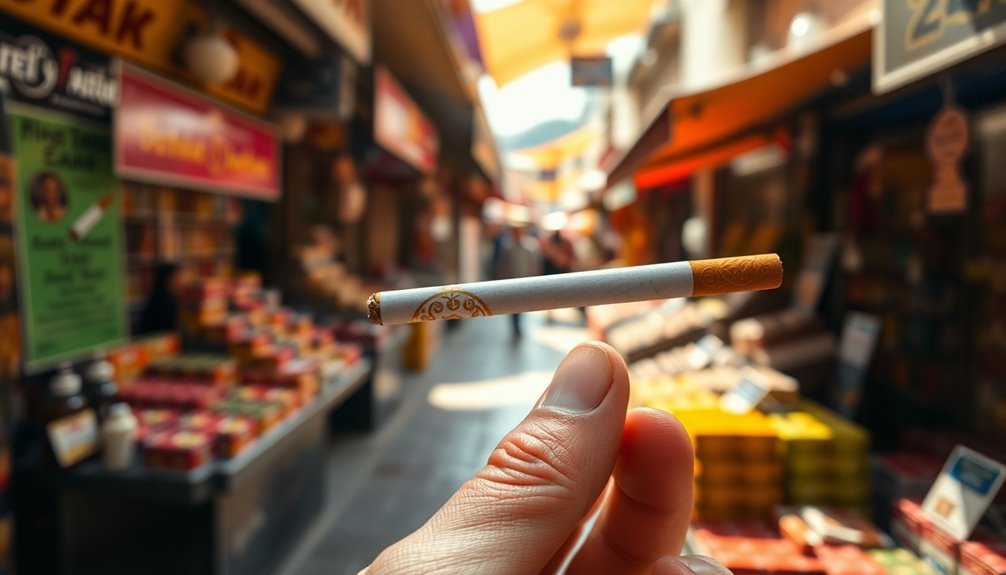Turkish cigarettes are undergoing significant changes worth knowing. The market has rebounded to $1.1 billion in 2023, driven by rising international demand. However, youth smoking remains a concern, with about 17.9% of teenagers lighting up. Adult smoking rates are high too, with approximately 30.7% of adults indulging. Tobacco causes serious health issues, claiming nearly 85,000 lives annually, which adds strain to the economy. Although government regulations exist, enforcement is often inconsistent. As these trends unfold, it's crucial to stay informed on how they impact health and society. There's more to uncover about this evolving landscape.
Key Takeaways
- The Turkish cigarettes market is valued at $1.1 billion in 2023, showing recovery after a two-year decline.
- Youth smoking rates are concerning, with 17.9% of ages 13-15 engaging in tobacco use.
- Adult smoking prevalence stands at approximately 30.7%, equating to nearly 19.8 million smokers in Turkey.
- Smoking-related diseases cause about 85,000 deaths annually, accounting for 13% of all deaths in the country.
- Regulatory challenges persist, with inconsistent enforcement of anti-smoking measures despite the ratification of the WHO Framework Convention.
Current Market Overview

The Turkish cigarettes market is experiencing a notable recovery, reaching a value of $1.1 billion in 2023 after two years of decline. This resurgence is part of a larger trend in the Turkish Tobacco & Tobacco Products market, which generated total revenues of $6,340.3 million in 2022.
With a compound annual growth rate (CAGR) of 13.8% from 2017 to 2022, the market is forecasted to grow significantly, aiming for $14,213.7 million by 2027 with an anticipated CAGR of 17.5%.
Cigarettes, including both filter and plain varieties, play a crucial role in this market. The production of tobacco-containing cigarettes has slightly expanded, with notable growth in previous years. In 2023, exports increased by a significant percentage, highlighting the growing international demand for Turkish cigarettes.
The rise in imports in 2023 underscores the increased demand for cigarettes, following a period of relatively slower growth. Philip Morris leads the market, while small local grocers remain key distribution channels.
Additionally, you'll notice a shift in consumer preferences towards queen size cigarettes, reflecting changing tastes in the market. As the average unit prices rise due to the Turkish Lira's devaluation, the landscape continues to evolve rapidly.
Youth Smoking Trends

As the Turkish cigarettes market rebounds, youth smoking trends present a concerning picture. Around 17.9% of Turkish youth aged 13-15 currently smoke tobacco, with boys at a significantly higher rate of 23.2% compared to 12.1% for girls. Specifically, 7.7% smoke cigarettes, while 12.8% use other tobacco products. High school students show even greater smoking prevalence, ranging from 13.4% to 35.7% across various studies.
Several factors influence these trends. Males and high-school students are more susceptible, often due to exposure to smoking peers, parents, and teachers. Anti-tobacco education appears to have a limited effect against the allure of smoking, especially when positive traits are attributed to smokers. Furthermore, the prevalence of smoking among Turkish youth is alarmingly high, indicating an urgent need for effective prevention strategies.
Additionally, over half of youth experience secondhand smoke in public places and homes, further normalizing tobacco use.
Social factors play a critical role too. Family dynamics, such as having a stepmother or siblings who smoke, can heighten smoking rates. Moreover, curiosity drives 1 in 10 youth to try e-cigarettes, raising concerns about their role as a gateway to traditional tobacco products.
Understanding these trends is essential for addressing youth smoking in Turkey.
Smoking Tobacco Consumption

How does smoking tobacco consumption in Turkey reflect broader health trends? The data speaks volumes. Nearly 85,000 Turks die each year from smoking-related diseases, with tobacco responsible for 29.2% of male deaths and 8.2% of female deaths. One in five deaths from cardiovascular diseases in Turkey ties back to tobacco use, while half of all chronic respiratory disease deaths are linked to it. The figures indicate smoking isn't just a personal choice; it's a public health crisis.
Secondhand smoke is also a concern. You mightn't realize it, but 10.6% of adults working indoors face exposure to tobacco smoke at their workplace, and over 51% of youths encounter it in enclosed public spaces. This widespread exposure contributes to an estimated 18.8 thousand deaths caused by secondhand smoke in 2021. Tobacco smoke exposure is particularly alarming, affecting nearly 12.7% of adults in restaurants.
Turkey's cigarette market, dominated by international companies, shows an increasing demand for tobacco products, rising from 63.8 packs per capita in 2010 to 67.3 in 2022.
The government's efforts to implement smoke-free laws and other tobacco control measures are essential to tackle this alarming trend. Your awareness and action can play a key role in changing the narrative around tobacco consumption.
Adult Smoking Prevalence

Understanding the impact of smoking-related diseases highlights the pressing issue of adult smoking prevalence in Turkey. Currently, about 30.7% of adults aged 15 and older smoke, which translates to nearly 19.8 million individuals. Among these, 41.9% are men, while 19.6% are women. This stark gender disparity points to a significant cultural and social acceptance of smoking among men.
The health consequences are dire. Nearly 85,000 Turks die every year from smoking-related diseases, accounting for 13% of all deaths in the country. One in five deaths from cardiovascular diseases and over half of all deaths from chronic respiratory diseases can be linked to tobacco use. Additionally, the economic cost of smoking in Turkey is exacerbated by the significant burden it places on families, diverting resources from essential needs.
These alarming statistics emphasize not just a public health crisis but also an economic one. The annual economic cost of smoking in Turkey reaches over 81 billion Turkish liras, impacting healthcare expenditures and productivity.
The highest prevalence of smoking occurs in the 35-44 age group, highlighting a critical area for intervention. As you consider these facts, it becomes clear that addressing adult smoking prevalence is essential for improving health outcomes and economic stability in Turkey.
Regulatory Challenges

Regulatory challenges in Turkey's tobacco control landscape present significant hurdles to effective implementation and enforcement of anti-smoking measures.
While Turkey ratified the WHO Framework Convention on Tobacco Control and established laws like Law No. 5727, enforcement remains inconsistent. You'll find that despite a comprehensive smoking ban in indoor public spaces, compliance is often lacking, and violations are common.
The tobacco industry continually resists advertising bans and seeks to negotiate policy changes, undermining efforts to curb smoking rates.
Additionally, the Tobacco and Alcohol Market Regulatory Authority (TAPDK) lacks the necessary infrastructure to manage regulations effectively, allowing more non-compliance to flourish.
While significant tax increases have made cigarettes less affordable and reduced consumption, the centralized governance structure has led to a lack of transparency and accountability in tobacco control efforts.
Recommendations for plain packaging, similar to Australia's approach, remain unaddressed, further complicating the situation.
Without a robust regulatory framework and genuine commitment to enforcement, you can expect these challenges to persist, hindering progress in Turkey's fight against tobacco use.
Economic Impact of Tobacco

Tobacco's economic impact is profound, affecting both individual households and national economies. Globally, smoking incurs over $500 billion in damages each year, with the U.S. alone losing an estimated $151 billion in productivity. This burden escalates, as tobacco use results in healthcare costs exceeding $1 trillion annually.
In Turkey, households with at least one smoker allocate nearly 8% of their monthly budget to tobacco, often at the expense of essentials like food and education, exacerbating poverty in already struggling families. Tobacco use leads to increased healthcare costs in Turkey, further straining public health resources.
While the tobacco industry generates significant tax revenues and employment, the costs it imposes on society can overshadow these benefits. For instance, in China, tobacco revenue accounts for 7.4% of government income, yet the indirect costs of smoking can reach 1% of U.S. GDP.
Implementing tobacco control policies, such as increased taxes, effectively reduces consumption, particularly among youth. This not only fosters public health but also supports economic stability and sustainable development.
Ultimately, the economic landscape surrounding tobacco is complex, revealing a balance between immediate benefits and long-term societal costs.
Health Consequences of Smoking

The economic burden of smoking in Turkey extends far beyond financial costs, impacting public health and individual well-being.
Smoking significantly harms your respiratory system, leading to devastating diseases like lung cancer, which claims nearly 85,000 Turkish lives each year. Chronic bronchitis and emphysema are common among smokers, making it tough for you to breathe due to airway damage and inflammation. Additionally, smoking is responsible for 90% of lung cancer deaths in men, underscoring its lethal impact.
Your cardiovascular health also suffers. Smoking increases your risk of coronary heart disease and stroke by two to four times, while narrowing blood vessels reduces circulation. This can lead to serious conditions like peripheral vascular disease and heart attacks.
Moreover, smoking raises your cancer risk dramatically. Men face a 23 times higher risk of lung cancer, while women are 13 times more likely. With over 70 cancer-causing chemicals in tobacco smoke, the threat is real.
It doesn't stop there. Smoking can lead to type 2 diabetes, reproductive issues, and even lower bone density in postmenopausal women.
The overall impact on your health is severe, reducing oxygen flow and increasing inflammation throughout your body. It's time to consider the consequences of smoking seriously.
Frequently Asked Questions
What Factors Influence the Price of Cigarettes in Turkey?
The price of cigarettes in Turkey is influenced by several factors.
You'll notice that taxation plays a crucial role, with high excise taxes on tobacco products driving up costs.
Economic conditions also matter; as the economy grows, affordability increases demand.
Additionally, consumer behavior affects prices; lower-income smokers are more sensitive to price changes.
Lastly, market dynamics, including the presence of transnational companies, impact the types of tobacco used and ultimately the price you pay.
How Does the COVID-19 Pandemic Affect Smoking Habits in Turkey?
The COVID-19 pandemic significantly influenced smoking habits in Turkey.
You might notice that many smokers felt motivated to quit due to fears surrounding the virus, with over 78% attempting short-term cessation.
While some maintained their habits, a notable percentage reduced their daily consumption.
The pandemic also shifted access to tobacco products, encouraging more people to buy from taxed dealers.
Are There Any Tobacco Cessation Programs Available in Turkey?
Yes, there are several tobacco cessation programs available in Turkey.
You can access Smoking Cessation Clinics (SCCs) that offer a combination of cognitive-behavioral therapy and pharmacotherapy, making quitting more effective.
The Turkish Ministry of Health provides medications free during specific campaigns, and admission is covered by the Social Security Institution.
However, you might find that many aren't aware of these services, so it's important to seek out information on local clinics.
What Demographics Are Most Affected by Tobacco Marketing in Turkey?
You'll find that youth aged 13-15 are significantly impacted by tobacco marketing, with nearly 18% using tobacco products.
Boys are particularly vulnerable, with over 23% smoking.
Male adults also face heavy marketing, as 44% of men aged 15 and older smoke.
Additionally, lower-income populations are targeted aggressively, leading to increased health risks and economic burdens.
How Do Cultural Attitudes Towards Smoking Vary Across Turkey?
Cultural attitudes towards smoking in Turkey vary significantly. In many regions, smoking's seen as a social norm, especially among men, while non-smoking is less accepted.
You'll notice that peer influence plays a big role; if your friends smoke, you're more likely to consider it.
However, in urban areas or among younger generations, there's a growing awareness of health risks, leading to shifts in attitudes and a gradual move towards non-smoking norms.
Conclusion
In conclusion, staying informed about the trends in Turkish cigarettes is essential. You've seen how youth smoking rates are shifting and the challenges faced by regulators. The economic implications and health consequences are significant, impacting both individuals and society. By understanding these dynamics, you can make more informed choices about smoking and advocate for healthier alternatives. Embracing this knowledge empowers you to contribute to a healthier future and support efforts to combat tobacco-related issues.










